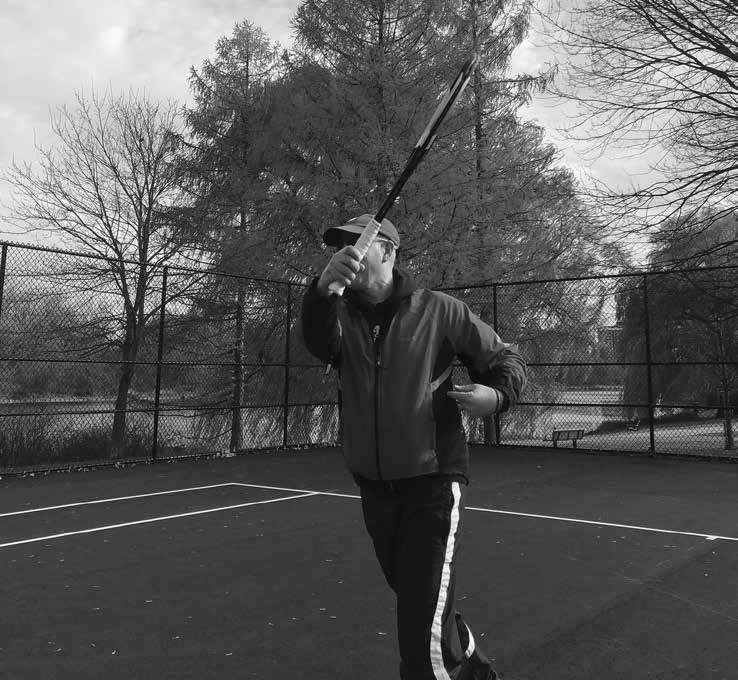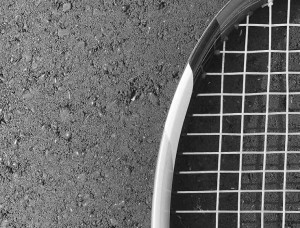
Racquet sport enthusiasts can rejoice over the newly resurfaced tennis and pickleball courts at Brantwood Park. Photo by Aliya Henderson
David Henderson
Tennis and pickleball players who make use of the Brantwood Park courts are well aware of the work the City of Ottawa has undertaken this fall to lay-in a new court surface and install a fence. The court surface at Brantwood, according to the City, was nearing its 40th year. The cracks and bumps had been repaired many times, and frustrated users began taking self-help steps, filling in the ever-increasing cracks to reduce the chance of tripping.
There are approximately 200 City managed courts in Ottawa, the conditions of which range from very poor to excellent.
With the assistance of the office of Shawn Menard, City funds were set aside to refurbish the degraded court surface at Brantwood. First scheduled for summer 2022, the work was delayed, and October finally saw ‘shovels in the ground.’ As the work ended in late October, however, it became evident to users that the new playing surface was uncoated asphalt, without the application of any acrylic protective covering.
Early users of the newly resurfaced court have observed that the asphalt surface shows high potential for damaging water infiltration (see photo). According to the City’s Asset Management Branch (the Branch), “(t)he new asphalt is a finer grade granular which produces a smooth surface finish with a similar if not better finish than courts with acrylic coating.” The Branch believes acrylic coating does not extend the life of the asphalt court surface, which it estimates to be typically between 20 and 30 years, without protective treatment. The Branch maintains that the main purpose of the acrylic layer is to improve aesthetics and provide a smoother finish.
A quick survey of other City managed municipal courts reveals that the application of some sort of surface protective covering has been consistent. The three courts in St. Germain Park (adjacent to the University of Ottawa Minto Centre) include protective covering, and they are deemed to be in good condition. Other examples of courts with a protective surface in good condition include, among others, Windsor Park (four courts), and Canterbury Park (two courts).
More recently, the four courts at Riverain Park (behind Rideau Sports Centre) were resurfaced with a protective covering. These courts were included as part of an entire park redevelopment which was funded by the Cash in Lieu of Parkland, as was the recent work completed at Brantwood Park. According to the City, the work at Riverain was done with the community’s understanding that the acrylic coating is not something the City will be required to maintain.
By contrast, the surface of the court at Playfair Park is asphalt, and it is considered to be in fair to poor condition.
A knowledgeable local sport court contractor, Chris Smith Canada Court, promotes the use of colour coating or products like DecoTurf (registered trademark) for low-maintenance court surfaces at a variety of prices. According to the company’s website, a quality, low-maintenance court surface should begin with concrete or asphalt, followed by an acrylic resurfacer, a texture course providing a uniform surface texture. Finally, a finishing course is applied creating a durable finish, and resistance to weather and ultraviolet degradation.
Sergio Carraro, an analyst with the Branch, told The Mainstreeter that, in relation to the Brantwood renewal project, “(t)he cost to renew a tennis court varies year to year. The cost of asphalt greatly fluctuates with the cost of crude oil. Recent labour challenges and demand also drive the cost. The total cost for this resurfacing project was close to $300,000.” Project costs, however, included the cost of “removals, a new accessible pathway and benches, new fencing, new tennis post and nets, larger asphalt area extending past the fencing in order to prevent the grass from creeping onto the courts, as well as design fees,” Carraro noted.

But users can legitimately question why the new court surface hasn’t been protected with an acrylic overlay coating to seal the permeable asphalt. Photo by Aliya Henderson
The obvious question to ask is why would the City, in undertaking the costly work to resurface the Brantwood courts, not take the added step to apply a protective acrylic covering atop the asphalt, a step which experts in the field suggest serves to extend the life of the court surface? The City explains that it decided about six years ago to no longer apply the coloured acrylic coating to new tennis courts as it cannot maintain the cost of the recommended re-application cycle of every seven to ten years. The cost of applying the coloured acrylic coating is estimated to be close to $10K per court.
According to the City, the new asphalt used at Brantwood is expected to provide a smooth surface while maintaining it’s colour longer than the type of asphalt used for road resurfacing. City staff noted that they are always looking for new ways to provide appropriate service without sacrificing the playability of the tennis and pickleball courts.
The Mainstreeter asked the Branch whether the City had ever done a comparative costing study to base its current policy of not applying acrylic protective coating to asphalt courts. In response, the Branch advised: “No study has been performed since [the policy was put in place] nor is one planned. The acrylic coating applied is not an alternative to covering up old asphalt. There will always be a need to have complete rebuilds of the courts even if the acrylic coating was placed. Over time, the asphalt dries out and cracks, larger cracks form and vegetation starts to grow in the cracks.
“The reason the acrylic coating is no longer applied to courts is that we have found it was not extending the life of the asphalt. It is (…) considered a premium playing surface, which is an increased cost to the City, times 200+ courts citywide. To close, since the City is no longer applying the acrylic coating, the type of asphalt mix has been changed in order to provide that desirable smoother surface the acrylic once provided,” Carraro said. But for active users of the Brantwood courts, the jury is still out on the new unprotected asphalt surface, and on the City’s six-year-old cost-saving policy






